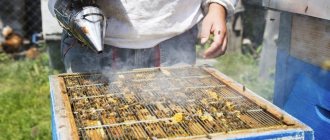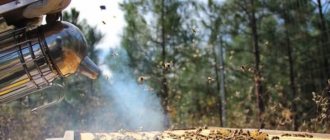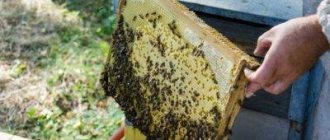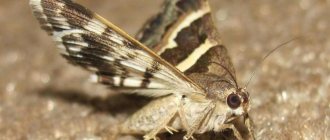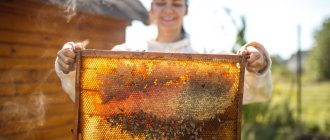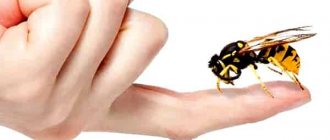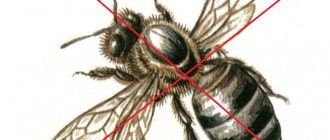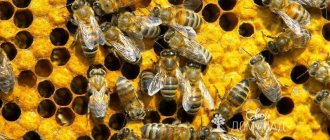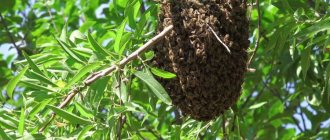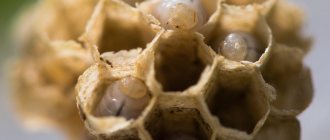Beekeeping is not only about collecting honey, but also about treating insects with special solutions. To do this, they use equipment called a smoke cannon for processing bees. Smokers are used to rid insects of mites and dangerous diseases.
The use of this device allows you to specifically introduce medicine into the hive, the process goes much faster, and the consumption of the medicine is reduced.
What to use as fuel?
As noted at the beginning of the article, insects do not like acrid smoke, and therefore the selection of fuel must be approached with all responsibility. Do not use dry straw, sawdust, or wood. It is important that the fuel does not burn, otherwise sparks can burn the bees. Ideally, hives should be exposed to low-temperature smoke. rotten wood as fuel - it can be collected from fallen trees and old stumps. The smoke from the dust will be soft and non-hot, i.e. comfortable for insects.
The main disadvantage of rotten wood is that it burns quickly. The smoker has to be refilled frequently, which may not be profitable. Therefore, instead of dust, they often use a dry fungus - tinder fungus , which grows on trees in the form of solid growths. The smoke from the mushroom is just as comfortable for bees as from dust, but it will emit much longer.
The third option is oak bark , preferably slightly damp. It will not catch fire, will smolder for a long time, and the smoke will be comfortable for insects.
Oak bark
>Components
The structure of the device is simple, but effective in saving bees from mites and diseases.
Design:
- A container into which the medicine is poured. Typically, the container is made of plastic. This greatly simplifies the design;
- The tube through which the solution is supplied from the container for heating and output;
- Pump. The device supplies the medicine from the container into the tube and then pushes the vapor out;
- A lid that covers the tank to prevent foreign objects from entering the liquid;
- Nozzle. The device is located at the tip of a tube that is inserted into the hive. The resulting steam is uniformly sprayed through the nozzle;
- The valve through which gas is supplied to the burner;
- Burner. The fuel for the smoker is gas supplied from a special container. Thanks to the burner, the medicinal solution is heated and converted into steam;
- Ignition trigger. This is a kind of lighter that creates a spark and the gas ignites;
- A regulator aimed at controlling the flow of solution into the tube. This is a bolt installed at the outlet of the medicine container;
- Gas cylinder. As a rule, the container is removable and reusable;
- Threaded connection and ring that is used to clamp the can.
It should be noted that the equipment used can operate not only on gas. There are also devices that use gasoline and kerasin as fuel. On sale you can find an electric smoker powered by AAA 1.5V batteries.
What to fill the smoker with?
The bee smoke atomizer can be filled with absolutely any raw material - paper, egg shells, dry grass, hay, straw, pine branches, cones, firewood, leaves, sawdust, Hessian fabric, etc.
Experienced beekeepers recommend paying attention to the following natural fuels:
- rotten trees, old stumps, dry manure, rotted wood - these materials do not harm insects, but burn out too quickly;
- tinder fungus (mushroom) - ignites well and smolders for a very long time, but finding it is problematic (unless you live near a forest where there are a lot of trees);
- oak bark is an excellent option, since it does not burn, but smolders.
When choosing, first of all, they adhere to the basic requirement - the raw materials must be natural so as not to harm the honey plants. Secondly, they focus on what is “at hand”.
When to use
In order to get the maximum result from using the medicine, therapeutic measures should be carried out in spring - early summer. Before mite treatment of bees begins, all honey should be removed from the hive. The use of chemicals has a negative impact on the human condition.
This means that when spraying there should be no honeycombs in the house.
I advise experienced beekeepers to take into account the following points when working:
- The use of the drug is carried out in the evening, when all the bees have returned home and are not going to fly out further;
- Pay attention to the wind. If it is not there, then you can safely fumigate the bees with smoke, without covering the houses. If it is windy outside, then in order for the product to remain inside and not erode, the entrances in the building are closed and they try to cover them with additional plastic film. 30 minutes is enough for the product to start working, you can remove the cellophane and open the tapholes;
- Check for brood. If there is, then the spraying is divided into two passes. Allow 10 minutes between steam injections. To obtain results, the treatment should be repeated no earlier than after 24 hours. These manipulations allow you to remove mites from the growing brood.
Experienced beekeepers also recommend doing preventive procedures for bees in the fall, in order to prepare the hive for wintering. Thus, pests that are located next to the entrance or directly on it are destroyed.
In this case, you should pay attention to the ambient temperature when bees are treated with a smoke gun in the fall. It shouldn't be colder than 2-8 degrees outside.
Manufacturing
A bee smoker is a simple device that you can make yourself. One way is to make it, for example, from a teapot, and you don’t even need complex drawings. The device is made as follows: the handle is separated from the metal kettle, a hole with a diameter of 12 mm is punched at the bottom at the place where it is attached, and two more are punched on the same bottom side - 8 mm at different heights for attaching the bellows.
The spout on the kettle will serve as a hole for blowing out smoke. The kettle lid will need to be secured with snap clips. The glass will be an ordinary tin can, in which a large number of recesses are made at the bottom and half the height so that air can pass through to the fuel.
The ends of the metal strips are bent so that the end result is a U-shaped part with a height of 3 mm, and are placed parallel to each other at a distance of 4 cm. A glass jar is installed on these strips. The distance from the bottom of the kettle to the bottom of the tin glass is made to allow air to get into the fuel. Then take 2 more iron strips and also bend them at the ends so that the top is 40 mm long.
Holes with a diameter of 8 mm are punched in the bent ends of the strips. The same notches are made in one of the prepared boards. These notches should fit into the notches on the kettle. A hole is made on the bottom of the same board - 12 mm, it should correspond to the one made on the kettle in height. Then, the iron curved strips are bolted to the body and board.
A tube is installed in the lower recesses on the body and board; it must be attached very tightly. A hole is also punched in another board; from the inside it is covered with a piece of leatherette, which is attached to the top. This will serve as a valve that will let air in, but will not release it when the bellows is compressed.
The second board is attached at an angle of 45 degrees to the first, with a strip of leatherette. A tension spring is placed between the two boards. When holding a 45 degree angle between the boards below, they are fastened with furniture buttons with leatherette bellows.
Recipes for solutions
To treat insects, various drugs are used to rid the bee colony of mites, parasites, and diseases. Also used to eliminate mold inside the house.
The following types of solutions are used:
| 1 solution | 2 solution | 3 solution |
| Ethyl alcohol, oxalic acid, thymol | Bipin, refined kerosene | Clartan, water |
| The mixture is heated in a water bath until the acid crystals dissolve. After a homogeneous liquid is obtained, thymol is added and also dissolved. Can be stored for 21 days | . Instead of beeping, “tactics” is used. The finished solution has a whitish tint. The mixture can be stored for 2 months | . Everything is heated in a water bath until a clear liquid is obtained. The solution cannot be stored, must be used immediately |
Refueling and maintenance
The prepared medicinal solution is poured into the container, from where liquid for heating will be supplied.
To extend the service life of the equipment, you should follow the operating and maintenance rules:
- The device should not be disassembled unless necessary. Also, the lack of special knowledge will lead to depressurization of components, making it impossible to further use;
- When using a mixture: ethyl alcohol, oxalic acid, thymol, the system must be flushed after each use to prevent scale formation. Table vinegar is used for this;
- The filter requires periodic cleaning;
- Before storing the smoke cannon for long-term storage, you should flush the working system with kerosene.
It needs constant care, factory equipment, and a homemade cannon for treating insects.
DIY drawing for assembling the Varomor smoke cannon
A good smoke cannon for bees is assembled with an Atex burner. The element is easily attached and removed due to the clamping screws. To disconnect the burner, loosen the bolt on the flange and tank. The element is rotated 90°, after which it is easily disconnected.
Methods for marking queen bees
The coil is bent from a copper tube with a diameter of 6 mm. The thickness of its walls is at least 3 mm. The inner diameter of the tube is also 3 mm. Due to the thick walls made of heat-intensive metal, the smoke gun coil heats up quickly, but takes longer to cool down.
The optimal dimensions of a homemade burner are 70x35 mm. The outer casing is bent from a stainless steel sheet. A flange and plug of the burner are provided with a side of about 5 mm for ease of assembly of the structure. After connecting the parts, holes are drilled in the casing with a diameter and a pitch of 6 mm from each other. A handle is welded to the flange. The second end of the copper tube is arbitrarily pressed with a clamp to the gas cylinder. The nozzle on the sprayer is made with a diameter of 15 mm. The part is turned on a lathe or the nozzle is removed from a household gas stove.
Assembling a smoke cannon for processing bees
The smoke cannon for processing bees is assembled according to the instructions in the following order:
- Connect the gas cylinder to the burner. Threads are cut on the copper tube and fittings are screwed on. Seal the threaded connection with FUM tape.
- The tube is shaped into a spiral of five turns. The outer diameter of the workpiece is 10 mm less than the thickness of the spark arrester flask. The spiral is placed inside the cola towards the end for better heating. A nozzle from a household gas stove is screwed onto the end of the tube.
- The spark arrestor flask is perforated. A strip with a hole for securing the copper tube is welded at the front. A coupling is attached to the back of the flask for connection to the burner. After assembly, the edge of the burner should extend 10 mm beyond the flange. The workpieces are connected by welding. You can drill holes on the flange and tighten them with bolts.
- Install a plastic container for the solution. A spray gun flask with a capacity of 200 mm is suitable.
After assembling all the elements, the supply of solution by the fuel pump is calibrated. A hole is drilled in the center of the foot and a screw is inserted. A solution is introduced into the nozzle and the flow of 1 cm 3 of liquid is adjusted.
Don't forget about safety precautions!
When working with a smoke gun, be sure to adhere to generally accepted safety standards.
- Do not use a device that shows obvious mechanical damage. Otherwise, the consequences may be the most tragic - members of your family may become victims of troubles.
- Store the smoke cannon in a separate room with sufficient air flow.
- Do not eat, drink or smoke while operating the device.
- Don't stand against the wind. Also, when fumigating your hives, try not to inhale the air from the cannon.
- Finally, use a respirator and other protective equipment.
On a note ! If malfunctions are detected in the operation of gas equipment, it is preferable to contact specialists rather than try to fix everything yourself.
Master Class. How to make a simple smoker with bellows
Let's look at how to make a simple smoker for bees with your own hands. To work you will need the following tools :
Metal shearsDrill bitAnvilHammerPuncherGood wire cuttersHacksawSharp knife
As for the necessary materials , they are as follows:
- stainless steel stand for toilet brush;
- leather (can be replaced with other dense material);
- ship nails;
- self-tapping screws;
- branched copper tube or brass sheet;
- bolts with nuts (can be replaced with copper rivets);
- empty candy jar;
- a pair of pine boards 5x90x150 mm;
- big spring.
Step 1 . First, disassemble the jar into a brush and remove all the plastic elements so that you end up with an empty pipe. Cut it to a height of about 170-200 mm, then take a candy jar and make the bottom out of it. Both elements should have approximately the same diameter. Use self-tapping screws to secure the bottom.
There should be empty space between the ignition and the bottom for more even combustion of the fuel. To do this, cut a circle from a metal mesh, bending it along the edges. You can, as in the example, not do this, but drill a hole and screw the mesh, although this is not necessary.
Step 2 . Cut out the funnel-shaped spout using a hammer, then drill holes and rivet the seams. Use a hammer to lap along the bottom edge to secure it to the lid. The last one is a lid from the same toilet brush. Use tin snips to widen the hole to securely attach the funnel from the inside and then secure with rivets.
Note! The spout can also be made from a curved copper pipe of at least 2.4 cm in diameter. To secure the lid, make 2 snap clips - attach them on both sides of the structure and snap them onto the lid.
The nose of the future smoker
Once you're done with the snaps, use a buffing pad to buff off any excess. Don't try too hard to make the smoker neat and beautiful, as it will already heat up. Plus, you use recycled materials. But the finished device will still lose its homemade appearance.
By the way, instead of rivets, you can use small bolts or self-tapping screws.
Step 3 . Take one of the boards, move 5 cm from the base and drill a hole approximately 1.5 cm in diameter. Nail a piece of leather on top. The board will serve as a lid on the inside of the bellows and at the same time as a one-way valve (air will be let in, but not released).
Take another piece of wood, move 3.8 cm from the base and make a hole 1.2 cm in diameter. Take the tube (brush handle) and insert it into the hole. The tube expands in one direction, and therefore there is no fear that it will fall out. Although, for extra security, you can add a little glue around the edges.
Step 4 . Cut a few coils from the spring, heat the ends with a torch and straighten them. Drill small holes at different ends of the boards into which the branches of the spring will fit. In the photos below you will see exactly how the spring should be attached.
Step 5 . For furs, it is better to use leather, although other dense material will also work. Cut out a piece of canvas 10x50 cm, sharpen each edge by 3.5 cm, so that the shape ultimately resembles an elongated diamond. In the middle there should be at least 8 cm of material of the same width, i.e. 10 cm is the future upper part of the furs, which should be flat. After cutting the fabric, trim the ends to prevent premature wear, and then fasten it along the edges of the frame (use furniture rivets with a pitch of about 12 mm).
Expert opinionPonomarev Sergey StepanovichBeekeeper with 30 years of experience, Candidate of Technical SciencesHaving secured the edges of the canvas, install the spring. In the example, the length of the edges of the spring is 3.5 cm, and therefore they just need to be inserted into the holes without any additional fastening.
Step 6 . Take brass strips 2 cm wide, fasten one end with buttons to the outside of the bellows, and screw the other to the sides of the fumigator. It is important that the bellows are located 3.5 cm from the body. The upper part of the bellows is also removed from the fumigator (about 3.5 cm), so that sparks and ash will not fall on them.
Combining bellows and fumigator
Armed with a chisel, punch a hole in the fumigator with a diameter of 1.2 cm, 6.3 cm from the bottom. The outlet tube should extend approximately 3 cm into the bellows, which, in turn, are attached to the body with strips of brass.
Make sure that nothing is loose and there are no gaps - it is important that the outlet tube fits snugly into the hole in the housing.
Step 7 . Check the smoker. Open the lid, place moss, leaves and brushwood inside, compact them, but not too hard. Light the fuel, and then if the fire starts, put the lid back on. You can use some green herb to increase the volume of smoke. By the way, we recommend pumping up the bellows from time to time to maintain the fire, even when there is no need for smoke.
Actually, that's the whole process. A homemade smoker for bees is assembled, tested and ready for full use!
Ready-made beekeeper smoker, made by yourself
Brief characteristics of the equipment
The principle of operation of a smoke cannon is very simple. It is based on heating with evaporation of the necessary drug mixed with a chemical solvent. These manipulations are carried out to treat bees, most often in the spring. If you prepare the medicinal solution correctly, it will contain a sufficient amount of active drugs combined with special irritating elements.
When producing pure honey products, you can use thymol or oxalic acid instead of chemicals. The gun has undergone many modernizations and improvements. For this reason, there is no doubt about its effectiveness and economy.
The dimensions of the device for treating bees are not too large:
- height – 300 millimeters;
- weight - about two kilograms;
- length - 470 millimeters;
- width – about 150 mm;
- not less than 100 p/s for 30 minutes of exposure.
The device for treating bees in spring consists of the following elements:
- nozzle;
- filter and pump;
- gas burner, tank lid;
- pump handle to pump the mixture;
- ignition of gas, as well as a tap for its supply;
- mixture tank;
- temperature igniter;
- bolt;
- pressure ring.
Structure
The tool for calming bees consists of several elements:
- A metal cylinder that consists of two layers;
- A device for supplying a stream of smoke into the firebox;
- A lid with a spout, which is most often called a “proboscis”.
Each of these elements performs a specific function - a metal cylinder produces smoke, has a closed bottom and a lid that hinges and has a proboscis. The elongated spout helps deliver smoke even to the most difficult to reach places. Using a mesh installed at the bottom of the cylinder, the refill does not come into contact with the smoke. If the beekeeper needs to introduce medications into the hive, then it is necessary to take a smoker with an extended nozzle.
Instructions for use
When using a smoke cannon, it is recommended to follow the instructions. This is necessary not only to obtain positive results after treating the bee house, but also to preserve human health.
How to make a smoke cannon for processing a family is already known, now you need to figure out how to use the equipment correctly:
- First, gas is supplied, then the burner is ignited. Now you can administer the medicinal solution. This is done by pressing the feed handle;
- Now you need to wait until the liquid reaches the spiral-shaped section and begins to heat up. You can treat the hive as soon as steam starts coming out of the nozzle;
- It is necessary to constantly regulate the supply of steam to the house;
- So that the steam produced gets inside the building. A nozzle is inserted into the tap hole to a depth of 3 centimeters;
- The number of presses on the steam handle depends on what the insects are treated with. If chemicals are used, press the feed button only twice. When a natural substance is poured into the container: thymol, oxalic acid, other acidic compounds, you need to press the feed handle five times.
Based on the above, we can conclude that there are no difficulties in using the equipment. The principle of working with Varomor is simple and convenient. After the treatment of the bee colonies and their inhabitants is completed, the gas supply valve is turned off.
How does a smoker work?
The design of the smoker is quite simple: these are two cylindrical containers of different diameters that are inserted into each other. The smaller container has a lattice bottom: fuel is placed there, and the ash can freely fall through the holes to the lower bottom.
Adding fuel to the smoker
A handle and bellows are attached to the body, which help to force air into the body; a cone-shaped tube is installed on the lid through which smoke comes out.
Furs are made from two wooden plates covered with dense material (faux leather is used more often than others, natural leather or dense fabric is used less often) and connected by a hinge.
To prevent sparks from flying out along with smoke, the design includes a special grille.
Modern manufacturers produce smokers with a built-in fan, powered by a battery or a spring mechanism; smokers in the form of a smoking pipe and others.
Components:
- Metal body in the shape of a cylinder (stainless steel or galvanized metal);
- An internal glass with a lattice bottom where fuel is placed;
- Lid with a folding mechanism and a hole for supplying smoke;
- Bellows for blowing;
- Check valve;
- Protective casing on the body;
- External lattice body.
Depending on the model, the design may vary slightly.
Principle of operation
The operation of the smoke cannon (Varomor) equipment is not a complex production process. A solution is poured into a special container and sprayed on the bees. The mixture then passes through a spiral tube, which is heated by a burner built into the structure.
As a result, the solution turns into steam, which is sprayed onto the bees by a cannon. Using the handle, you can adjust the flow of the heated medium. At the end of the unit there is a long straight tube that allows you to penetrate inside the structure without disturbing insects.
A smoke gun for therapeutic procedures weighs no more than 2 kilograms. Some people can easily operate the device on their own. The equipment dimensions are as follows:
- Height is 30 centimeters;
- Length – 47 centimeters;
- Width – 15 centimeters.
Within 30 minutes, the device makes at least 100 injections of the drug into the hive. It is preferable to carry out insect treatment in the spring. With the correct proportions, the medicine will be as effective as possible.
For those who value the purity of the final bee product, you can use thymol and oxalic acid instead of chemicals. From the moment the first device was created to the present day, the design of a smoke gun for treating bees against parasites has changed a lot and has become more advanced.
The equipment gives more results and saves the sprayed product. As a result of heating the mixture, the product enters the hive in the form of steam, which significantly improves the effectiveness of the drug. After cooling, the droplets settle evenly on insects and on surfaces inside the building.
Design
Next, you should familiarize yourself with the design of the smoker. It is not as complicated as it seems at first glance. The main element of the device is an outer casing in the form of a cylinder with a lid, inside of which a metal fuel cup is inserted.
The glass is slightly smaller than the body, so there is space at the bottom to collect ash. The lid has the shape of a cone, inside it there is a spark arrester so that the flame inside does not flare up too much. On the side are the so-called bellows; they consist of two planks, usually made of wood, fastened with a piece of leather.
Fuel is placed in the glass; it can be rotten vines, dry horse manure and other materials that produce thick smoke when smoldering. The fuel is ignited by air, it is accelerated by squeezing the bellows, and smoke begins to be released, which comes out of the lid.
Spraying rules
First, the infected dwellings are fumigated; for this purpose, the resulting solution is poured into the tank. Unscrew the cap and pour in the liquid. Don't forget to close the lid. After this step, open the gas cylinder by turning the tap handle. Press the ignition button to light the wick. Check the pressure; its edge should not cross the protection contour. Allow the device to warm up for a few minutes to reach the appropriate temperature.
Using the pump handle, feed the solution into the heating system. It is important to move the handle to your side in time so that the emphasis is maximum. Fumigation begins after thick and persistent smoke appears from the nozzle. The nozzle is inserted into the lower entrance of the hive, and several puffs of medicinal smoke are supplied. After the procedure, you need to close the gas supply valve. When working with such a device, follow the necessary safety rules.
How to light a smoker for bees
Lighting a regular beekeeper's smoker is as easy as shelling pears. The inner glass is filled with dry fuel. They set fire to a piece of crumpled paper and lower it into the body on top of all our rotten pieces, splinters, etc. Close the smoker with a lid. Using bellows we add air into the flask. Slowly at first, then as it heats up, maybe a little stronger. The rotten things begin to smolder, emitting thick smoke. This is the whole trick.
Another “old-fashioned way” (this phrase is infuriating, the only thing worse than using the word “extreme” to mean “last”) is adding pieces of propolis to the smoker. Allegedly, bees behave calmer with such smoke. I haven't tried it myself, so I can't say anything.
And finally, what to do if you urgently need to check on the bees, but you don’t have a smoker at hand - it’s broken, lost, borrowed by a neighbor, but who knows what, it doesn’t matter. A sprayer and mint drops will come to your aid.
Another smell that bees really love is the smell of lemon balm. It's an inconspicuous weed, but its smell reminds bees of the queen, and it's not customary to misbehave around the higher authorities. Therefore, you can rub your hands and face with lemon balm and it will be a little easier to work with bees. As you understand, this will not give you a guarantee against bites.
If you are interested in the design of a smoker for bees or how to make one with your own hands, as well as what types of smokers you can buy, then all this will be in the next article.
Operating principle
How does Varomor work?
During honey collection, Varomor can be filled with environmentally friendly preparations, such as oxalic acid or thymol, without using chemicals. In this case, tick control will also be effective. The resulting beekeeping products will be used without additional restrictions.
What can we say about the owners of large apiaries with a huge number of hives. Previously, fighting the varroa parasite took a lot of time and effort. Now, with the advent of Varomor, everything is much simpler and easier. A few hours are enough to combat the disease, and the beekeeper has plenty of free time.
IMPORTANT! Varomor is a godsend for beekeepers with a large apiary.
Before using Varomor, you should thoroughly study the operating and assembly instructions. All work on assembling the device should be carried out outdoors, because it contains gas elements, working with which indoors is strictly prohibited.
How to achieve abundant smoke emission from the Varomor smoke gun
The intensity of the formation of puffs of smoke from Varomor depends on proper use. Before fumigating the bees, the smoke gun must warm up for at least 2 minutes. When the Varomora burner is hot, the solution is supplied using the pump handle. One stroke of the handle supplies 1 cm 3 of liquid into the system. To increase the portion of smoke, again press the Voramor handle towards you until it stops and move it forward.
Causes of malfunction of the Varomor smoke gun and the possibility of eliminating them
If there is little smoke from the Varomor smoke gun, then it can be assumed that the pump or supply channels are clogged. This type of breakdown is most common when an unfiltered bee solution is poured. Siltation with solid deposits occurs when washing the Varomora system after fumigation of bees is ignored.
Cleaning the channels and pump of the smoke cannon is difficult. Flushing the Varomora system with kerosene after each bee treatment helps prevent breakdowns.
